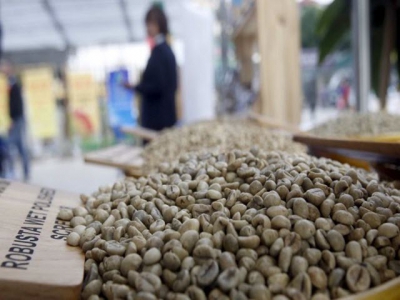Vietnam coffee prices fall in line with weak London; trade picks up in Indonesia

Vietnamese coffee prices fell this week in line with subdued London prices, but trade activities started to pick up for March contract in Indonesia, traders said on Thursday.
Coffee beans are displayed at an exhibition in Hanoi December 10, 2015. Photo: Reuters
Farmers in the Central Highlands, Vietnam’s largest coffee-growing area, sold coffee at 32,600 dong ($1.41) per kg, down from 33,600 dong last week, following a fall in ICE March contract.
March robusta coffee settled down $10, or 0.74%, at $1,354 per tonne on Wednesday.
“London prices have consistently been very low, under $1,400 per tonne since Dec. 19,” said a trader based in the region.
“Demands from exporters and roasters are still high but farmers refuse to sell at such low prices.”
Traders said farmers in the Central Highlands had harvested all of the fresh beans of the 2019/20 crop year.
“Beans are abundant but very hard to buy, exporters were not so keen on making new trade deals,” said another trader based in Ho Chi Minh City.
Traders in Vietnam offered 5% black and broken grade 2 robusta at a $100 premium per tonne to the March contract on Thursday, compared with last week’s $50 premium.
Indonesia’s grade 4 defect 80 robusta beans were offered at premiums of $220-$250 to the March contract this week, compared with $250 premium of a week ago, a trader in Sumatra’s Lampung province said.
Trade activities are starting to pick up for March contract, traders said, but demand is still relatively light this week.
Traders are waiting for the next harvest but they also suspect that farmers are still holding on to some bean stocks.
Có thể bạn quan tâm
 A gloomy year of rice exports
A gloomy year of rice exports Throughout the year, rice exports faced many difficulties with decreasing export value compared to the same period last year.
 Japan’s decision opens new doors for Vietnamese “thieu” lychee
Japan’s decision opens new doors for Vietnamese “thieu” lychee Japan’s recent decision of importing Vietnamese “thieu” lychee is expected to open new doors for this fruit, according to Vietnamese Trade Counsellor in Japan
 Main farm produce account for 66 percent of total agricultural production
Main farm produce account for 66 percent of total agricultural production According to the Department of Agriculture and Rural Development of Ho Chi Minh City, the group of major agricultural products accounted for 66 percent